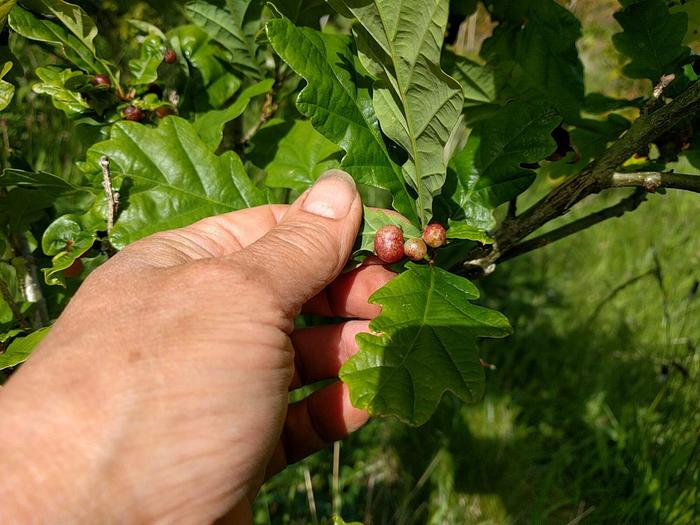
 12
12





-Lampblack (soot from burning a kerosene lamp)
-Gum arabic
-Distilled Water
Ian the Green wrote:-Tannic Acid (comes from galls from trees, like oak galls)
-Iron (from leftover nails)
-Some type of Liquid Base (water, alcohol, vinegar)
-Some type of Binder (Gum of Arabic, Glair, Fish Glue, or honey)
Ingredients:
-2 Iron Tablets (50mg ferrous sulfate)
-2 bags of tea (type unspecified)
-boiling water
-a small paper cup (size unspecified, but I'm guessing one cup)
Instructions:
1. Add 2 iron tablets into paper cup
2. Add in 2 tea bags to paper cup
3. Pour in boiling water
4. Wait five minutes (stirring was not mentioned, I don't know why)
Dave's SKIP BB's / Welcome to Permies! / Permaculture Resources / Dave's Boot Adventures & Longview Projects














 4
4




No rain, no rainbow.
 2
2




Bee Putnam
 2
2




bernetta putnam wrote:as a kid me and my friends would use the mashed up juice from prickly pear cactus apples, also makes great pinkish dye for anything.
No rain, no rainbow.
 4
4




Ryan Hobbs wrote:
bernetta putnam wrote:as a kid me and my friends would use the mashed up juice from prickly pear cactus apples, also makes great pinkish dye for anything.
Or, if you are anywhere between the Mississippi river and the Atlantic Ocean, Poke berries make a fuscia dye and ink.
 1
1




Dave's SKIP BB's / Welcome to Permies! / Permaculture Resources / Dave's Boot Adventures & Longview Projects


















Phil Gardener wrote:
Ryan Hobbs wrote:
bernetta putnam wrote:as a kid me and my friends would use the mashed up juice from prickly pear cactus apples, also makes great pinkish dye for anything.
Or, if you are anywhere between the Mississippi river and the Atlantic Ocean, Poke berries make a fuscia dye and ink.
I did this decades ago and remember it faded fairly quickly; that may be a concern with many plant extracts. It was pretty, however!
No rain, no rainbow.
 2
2








Matt Rountree wrote:I tried blackberries before. I added gum arabic to improve the viscosity. The resulted ink is purplish in color.
Dave's SKIP BB's / Welcome to Permies! / Permaculture Resources / Dave's Boot Adventures & Longview Projects














 1
1




"I could feel the olive tree rooting itself into my heart, showing me how to re-green my own journey and embark on a new path." ~ http://www.alicegriffin.co.uk




Dave's SKIP BB's / Welcome to Permies! / Permaculture Resources / Dave's Boot Adventures & Longview Projects














 7
7




 3
3




Dave's SKIP BB's / Welcome to Permies! / Permaculture Resources / Dave's Boot Adventures & Longview Projects














 2
2




Dave Burton wrote:Hot damn, Scott!!! That is so inspiring the potential walnuts could have for making ink!

 3
3




 But eeeh! That also improves the number of functions that can be gotten out of walnuts! You get the nuts, which you can eat, you get the ink that could be used for writing, and maybe maybe the husks could be composted or mulched after the ink has been taken out of them! Please keep me updated on what you do with the walnut husks!
But eeeh! That also improves the number of functions that can be gotten out of walnuts! You get the nuts, which you can eat, you get the ink that could be used for writing, and maybe maybe the husks could be composted or mulched after the ink has been taken out of them! Please keep me updated on what you do with the walnut husks!Dave's SKIP BB's / Welcome to Permies! / Permaculture Resources / Dave's Boot Adventures & Longview Projects














 6
6




Argue for your limitations and they are yours forever.
 7
7




~ Alicia (Author, forager, homeschooling nature lover)
Our family foraging and Sustainable Living Blog, A Magical Life: (http://magicalchildhood.com/life/)






 10
10





QuickBooks set up and Bookkeeping for Small Businesses and Farms - jocelyncampbell.com
 3
3




Jocelyn Campbell wrote:Judith wrote up great information and a nice review about The Organic Artist by Nick Neddo.
I haven't read it myself, but I hear it does include information on making inks.








 3
3











 3
3





 3
3





How Permies works: https://permies.com/wiki/34193/permies-works-links-threads
My projects on Skye: The tree field, Growing and landracing, perennial polycultures, "Don't dream it - be it! "









